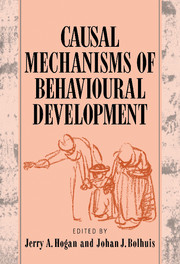Book contents
- Frontmatter
- Contents
- List of contributors
- Foreword: Introducing Jaap Kruijt
- Preface
- Part one Introduction
- Part two Development of perceptual and motor mechanisms
- Part three Development of behaviour systems
- Part four Development of cognition
- 11 Cortical mechanisms of cognitive development
- 12 Cognitive development in animals
- 13 The biological building blocks of spoken language
- Part five Learning and development
- Author index
- Subject index
13 - The biological building blocks of spoken language
Published online by Cambridge University Press: 19 January 2010
- Frontmatter
- Contents
- List of contributors
- Foreword: Introducing Jaap Kruijt
- Preface
- Part one Introduction
- Part two Development of perceptual and motor mechanisms
- Part three Development of behaviour systems
- Part four Development of cognition
- 11 Cortical mechanisms of cognitive development
- 12 Cognitive development in animals
- 13 The biological building blocks of spoken language
- Part five Learning and development
- Author index
- Subject index
Summary
I still recall a pronouncement from my earliest days of graduate training in linguistics that ‘phonemes are the building blocks of language’. I have forgotten who said it – possibly a number of linguists issued similar pronouncements and I am only recollecting a composite. In any case, the statement is believed by many individuals who study language. In this chapter I shall show that the phoneme is not the elemental unit best suited for understanding the development of spoken language.
The term phoneme refers to the smallest difference that can differentiate two spoken words. In English, /p/ and /t/ are phonemes because they distinguish ‘pie’ from ‘tie’, /s/ and /z/ are phonemes because they distinguish ‘hiss’ from ‘his’. It makes intuitive sense to suppose that these sound units are in fact the building blocks of language because words and grammatical markers are made of such sounds, and phrases and sentences are made of words. But this logic serves us poorly if our intent is to understand what human developments produce linguistic capacity and determine the form of linguistic behaviors. These are ontogenetic questions, and in asking them our concern cannot reside with elemental units of a behavior not yet acquired. Rather, we must concentrate on developmental mechanisms which facilitate or enable behaviors that – as the human child ultimately discovers – are decomposable into those units. From a developmental perspective, then, the phoneme is unavoidably a posteriori and therefore incapable of building any of the child's earlier behaviors.
- Type
- Chapter
- Information
- Causal Mechanisms of Behavioural Development , pp. 300 - 324Publisher: Cambridge University PressPrint publication year: 1994
- 2
- Cited by



